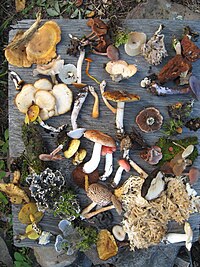
Photo from wikipedia
The expansion of rainforest pioneer trees into long-unburnt open forests has become increasingly widespread across high rainfall regions of Australia. Increasing tree cover can limit resource availability for understorey plant… Click to show full abstract
The expansion of rainforest pioneer trees into long-unburnt open forests has become increasingly widespread across high rainfall regions of Australia. Increasing tree cover can limit resource availability for understorey plant communities and reduce understorey diversity. However, it remains unclear if sclerophyll and rainforest trees differ in their competitive exclusion of understory plant communities, which contain most of the floristic diversity of open forests. Here, we examine dry open forest across contrasting fire histories (burnt and unburnt) and levels of rainforest invasion (sclerophyll or rainforest midstorey) to hindcast changes in understorey plant density, richness and composition. The influence of these treatments and other site variables (midstorey structure, midstorey composition and soil parameters) on understorey plant communities were all examined. This study is the first to demonstrate significantly greater losses of understorey species richness, particularly of dry open-forest specialists, under an invading rainforest midstorey compared to a typical sclerophyll midstorey. Rainforest pioneers displaced over half of the understorey plant species, and reduced ground cover and density of dry forest specialists by ~90%. Significant understorey declines also occurred with increased sclerophyll midstorey cover following fire exclusion, although losses were typically less than half that of rainforest-invaded sites over the same period. Understorey declines were closely related to leaf area index and basal area of rainforest and wattle trees, suggesting competitive exclusion through shading and potentially belowground competition for water. Around 20% of displaced species lacked any capacity for population recovery, while transient seed banks or distance-limited dispersal may hinder recovery for a further 68%. We conclude that rainforest invasion leads to significant declines in understorey plant diversity and cover in open forests. To avoid elimination of local native plant populations in open forests, fires should occur with sufficient frequency to prevent overstorey cover from reaching a level where shade-intolerant species fail to thrive.
Journal Title: Austral Ecology
Year Published: 2020
Link to full text (if available)
Share on Social Media: Sign Up to like & get
recommendations!